What is Garmin's warranty policy?
What is indicated by the letter U or X in the beginning of a serial number?
PLEASE NOTE: This FAQ was written over 10 years ago and does not apply as of April 2021. It should be considered as historical reference only.
Some Bendix/King avionics units have the letter U or X in the beginning of the serial number (e.g. X87544). Units with the letter X indicate that the unit is in like new condition and has been cosmetically enhanced. In most cases, faceplates and covers have been replaced by Honeywell so that the unit appears the same as a new unit would. In addition, the letter X indicates that the product is less than 3 years old, has the latest software and hardware mods installed, and was repaired by the factory or the factory repair and overhaul shop. Units with the letter U indicate that the unit in average physical condition and, in most cases, have not had much cosmetic enhancement done at the factory. These units are usually more than 3 years old but do have the latest software and hardware mods installed while being repaired at the factory.
How does Southeast Aerospace process "Exchange" transactions?
"Exchange" is a term used in aviation and most other parts industries to indicate the exchange of a known defective or unserviceable unit for a known good, serviceable unit. In most cases, in simple terms, exchanges are sought after when quick replacement of a defective unit is needed.
Southeast Aerospace's exchange price is based on a standard exchange. Additional billing will only occur if the cost to repair the core received exceeds the repair cap. The "repair cap" is the maximum allowable cost to repair the customer core. If the cost to repair the core exceeds the repair cap, the customer will be billed an additional fee equaling the difference between the repair cost and the repair cap. If the additional fee exceeds or equals the core charge, the core will be deemed to be beyond economical repair and the core will be billed back to the customer at the original stated core charge amount indicated on the exchange invoice. A billback of the original core charge amount will also occur in the vent that a core is not returned.
A standard exchange is only valid with the return of an economically repairable, normal core of the same model and same part number. A definition of a normal, repairable core is a unit that has experienced a normal equipment failure not related to an incident (i.e. fire, water damage, or act of nature) or improper installation. Units that have been heavily modified or extensively, unproductively worked on are not accepted as exchange cores. In rare cases or situations, exchanges may be conditional based on the serial number or service bulletin threshold of a unit due to certain older units not being supported by the manufacturer.
What is OHC or overhauled in relation to avionics?
The term OHC or overhauled condition is widely used and can be defined in many different ways depending on the sector of aviation in question. Most broadly, this terms refers to the inspection and cleaning of an electronic component (in this case) as defined by Federal Air Regulation Part 43.2. The FAA mandates that certified repair stations not only follow any prescribed overhaul procedures listed in a component's maintenance manual but also inspects and verifies that all mandatory service bulletins and subsequent airworthiness directives are complied with. In addition, when certifying a unit as &overhauled&, the repair station must verify and validate that all modifications and/or service bulletins marked on the mod chart or dataplate of the unit are indeed incorporated in the unit. Likewise, most repair stations improve cosmetics and overall appearances of unit they may be certifying as overhauled since this should be included in the cleaning and inspecting of a unit.
What is required to certify an IFR APPROACH approved GPS into my aircraft?
Why doesn't Southeast Aerospace offers exchanges for the Collins DME-40?
Why does Southeast Aerospace certify some units as only SV, Inspected, or Repaired?
Why does Southeast Aerospace not offer exchanges on the TPU-66A TCAS Processor?
Are KMT-112 flux valves repairable?
Why did Bendix/King change their part numbers from a 9 digit to a 12 digit format?
Different software versions imply different operational features and/or interface capabilities and software modifications imply software repairs (bug fixes) to insure proper operation of these features and interfaces. Software version upgrades frequently require hardware modifications to the unit. Such hardware modifications accompanying software version upgrades do not necessarily change the hardware version of the unit.
What does the E in front of a Honeywell unit's serial number indicate?
What are the reliability and warranty issues with the KX-155A nav/comm?
From a purchasing standpoint, Southeast Aerospace cannot purchase units under serial number 24100 since we offer a 6 month warranty when these units are sold. Since there is the possibility that the transmitter in the KX-155A could fail within 6 months, it is not practical to obtain units below serial number 24100.
Why does my 406 MHz ELT need to be programmed?
An Emergency Locator Transmitter (ELT) should be programmed with either the aircraft tail #, a serial #, or the aircraft operator designator. The aircraft information programmed is determined by your country's requirements. The information is sent to the government agency responsible for keeping the database of the country in which your aircraft is registered.
The ID is linked to your SAR database, containing valuable aircraft information: Type of Aircraft, Address of Owner, Telephone # of Owner, Aircraft Registration #, and Alternate Emergency Contact, etc.
Keeping this information up to date & accurate is a major concern of the Search & Rescue Centers. Without accurate information, valuable time may be lost in attempting to locate the owner of the aircraft.
Your ELT can easily be programmed by a certified repair station, such as Southeast Aerospace.
Contact Southeast Aerospace today for more information on ELT programming.
Is there another unit to directly replace the KI-214 Indicator w/ glideslope
No, however Southeast Aerospace suggests replacing the KI-214 with a separate VOR/LOC/GS indicator and glideslope receiver such as the KI-209 and KN-75.
The KI-214 is no longer supported by Bendix/King (Honeywell) and most service parts needed to repair the KI-214 are not available. As always, it is the installer's responsibility to verify compatibility of the KN-75 GS receiver with the Nav radios installed in the aircraft.
What is the definition of the condition "Refurbished" on the SEA website?
What is the definition of SEA's "Average Repair & Overhaul" prices?
Please Note: In most cases, the following factors will affect the cost to repair or overhaul an item:
- Age of Unit
- Service Bulletin Status
- Operation Environment (climate, humidity, vibration, etc.)
How much does the radome on an aircraft affect weather radar performance?
- Pitted radome caused by rain, ice, sand, or bugs at high speeds
- Poorly sealed radome that can allow moisture to become trapped behind it
- Paint containing metallic particles is applied to all of part of the radome
- Improperly manufactured fiberglass radome
- Improperly repaired ding in the radome
- Object inside the radome and in the path of the transmission
Can I use a Primus 300 Slimline Indicator (DI-2007) with the standard Primus 300 Receiver-Transmitter (RT-3001)?
The Primus 300 Slimline system consists of the DI-2007 indicator, RT-3002 receiver/transmitter, and AP-3001 antenna pedestal.
Why should I replace my KA-51A slaving control with a KA-51B?
The KA-51A is the slaving control that was originally part of the KCS-55A compass system. It has since been replaced by the KA-51B, mainly due to durability problems with the faceplate mounting holes. Since introduction of the KA-51B, Bendix/King has ceased production of replacement parts for the KA-51A, thus making it virtually unrepairable.
Please note that the KA-51B is not a direct replacement for the KA-51A, but is an easily performed upgrade that only requires replacement of the connectors.
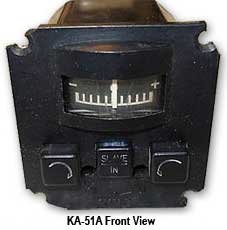
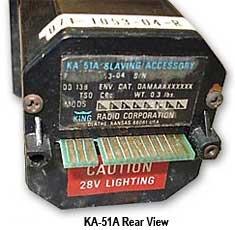
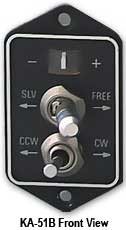
What is meant by "Economically Repairable"?
- For purchases, the cost to repair the unit cannot exceed 75% of SEA's Outright Price.
- For exchange core approval, the cost to repair the returned core cannot exceed 75% of the Exchange Price.
I currently have a KR-85 ADF that continues to give me trouble, should I buy another KR-85 or consider upgrading?
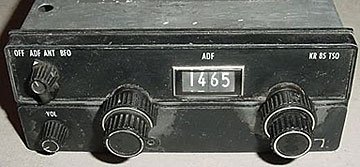
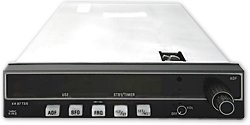
Instead of continuing to invest your money in obsolete technology and delaying the inevitable, Southeast Aerospace suggests upgrading to the KR-87 ADF. Investing in the KR-87 will provide you with an ADF that includes warranty and support for many years to come. Plus, since the KR-87 is smaller it will free up valuable panel space in your aircraft.
I have an ST3400 that has started to discolor in the center of the display screen, can this be repaired?
Yes, Sandel has recently released a service bulletin addressing this issue. The problem has been traced to improper manufacturing tolerances used in the installation of a plastic polarizer in optical system, which does not meet published specifications. Sandel has stated that this problem does not present a flight safety concern and that it is only a cosmetic defect. This service bulletin applies to all serial numbers, shipped prior to August 24, 2009.
A glass polarizer has been designed as a replacement that does not the present the discoloration problem. This part can be retrofitted by the factory into any LED backlit unit.
Identical service bulletins on this problem have also been issued for the SA4550, SN4500 and the SN3500.
Can a U.S. based EASA 145 repair station issue a dual release tag solely based on FAA criteria?
I currently have a KN-65 DME that needs to be replaced, should I buy another KN-65 or consider upgrading?
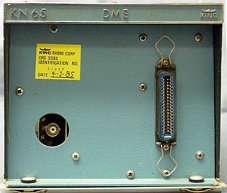
KN-65
Until the used market completely dries up, you can still find someone who will sell you a KN-65. The KN-65 may have been a cost effective, reliable unit at one time but unfortunately its time has passed. Most older avionics units have become increasingly challenging to repair as the manufacturers discontinue support and cut off the supply of service parts. Likewise, even if you can find a KN-65 in working condition, it usually has little or no warranty.
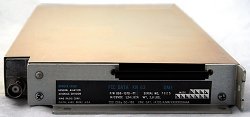
KN-63
Instead of continuing to invest your money in obsolete technology and delaying the inevitable, Southeast Aerospace suggests upgrading to the KN-63. Investing in the KN-63 will provide you with a DME that includes warranty and support for many years to come.
Is it true that the KI-202, KI-203, KI-204, and KI-206 are not repairable if they are below serial number 10000?
I currently have a KMA-20 audio panel that needs to be replaced, should I buy another KMA-20 or consider upgrading?
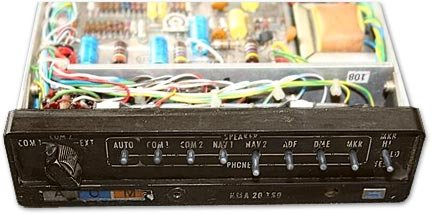 Until the used market completely dries up, you can still find someone who will sell you a KMA-20. The KMA-20 may have been a cost effective, reliable unit at one time but unfortunately its time has passed. Most older avionics units have become increasingly challenging to repair as the manufacturers discontinue support and cut off the supply of service parts. Likewise, even if you can find a KMA-20 in working condition, it usually has little or no warranty. Instead of continuing to invest your money in obsolete technology and delaying the inevitable, Southeast Aerospace suggests upgrading to the KMA-24. Investing in the KMA-24 will provide you with an audio panel that includes warranty and support for many years to come.
Until the used market completely dries up, you can still find someone who will sell you a KMA-20. The KMA-20 may have been a cost effective, reliable unit at one time but unfortunately its time has passed. Most older avionics units have become increasingly challenging to repair as the manufacturers discontinue support and cut off the supply of service parts. Likewise, even if you can find a KMA-20 in working condition, it usually has little or no warranty. Instead of continuing to invest your money in obsolete technology and delaying the inevitable, Southeast Aerospace suggests upgrading to the KMA-24. Investing in the KMA-24 will provide you with an audio panel that includes warranty and support for many years to come.

What details should I inquire about or consider when purchasing a KNI-582?
When a cracked motor plate is encountered, some shops opt to try and repair the plate by gluing it instead of replacing it. Likewise, you may encounter KNI-582 units with loud compass card motors. Once again, some shops may certify the unit with a loud motor to avoid the expense of replacing the old style motor according to Service Aid 102 as mentioned above. As expected, a loud compass card motor is a sign of an older motor that is wearing out or even possibly not working as it should.
According to our purchasing and service quality standards, Southeast Aerospace always performs Service Aid 102 as not only the correct repair action but as preventative measure as well. Remember, if you are purchasing a KNI-582 with a low serial number, always inquire if Service Aid 102 has been performed on the unit.
Why is Service Bulletin MST67A-34-56 important?
MST-67A P/N 066-01143-2001 units with serial numbers MST67A-F1450 and below are affected. MST-67A P/N 066-01143-2101 units with serial numbers MST67A-G2850 and below are affected.
Honeywell Service Bulletin MST67A-34-56 incorporates a software modification to address the enhanced data communication issues. This SB involves replacing to intergrated circuits on the IOP/DLP COM board and appropriate labeling.
Since safety and quality are of the utmost importance, Southeast Aerospace is pleased to inform its customers and prospective clients that we will incorporating the Honeywell Service Bulletin into all MST-67A P/N 066-01143-2001 and 2101 that are serviced and processed in our FAA/EASA approved repair facility. If you have an MST-67A that is affected by this Airworthiness Directive, please contact our Service Center at shop@seaerospace.com for more details on a quick, responsive solution.
Are SEA's Exchange prices negotiable?
Negotiating the exchange price of a unit only limits the allowable repair cap for the core unit. Southeast Aerospace's exchange transactions are based on the return of economically repairable core unit. Once the core is received and evaluated, the core repair cost incurred by SEA cannot exceed 75% of the original exchange price. That is, it cannot cost SEA more than 75% of the original OH/SV exchange price collected from the customer. Therefore, when and if an SEA exchange price is discounted, there is a risk that additional charges may be assessed once the core is returned and evaluated.
Why is the KT-76C not conducive to repairs?
What is meant by New Surplus (NS) condition?
Per the FAA, "Surplus" is described as "a product, assembly, part, or material that has been released as surplus by the military, manufacturers, owners/operators, repair facilities, or any other parts supplier. These products should show traceability to an FAA-approved manufacturing procedure."
"New Surplus" is a trade or industry specific term that is not officially recognized by the FAA. Unfortunately, "New Surplus" is a loosely used term by some parts supplier to describe items that may appear to be new and unused but have no documentation or certification to support the claim. Therefore, in most cases where items do not have traceability or proof of condition, such items are be considered "As Is" or "As Removed".
In FAA Advisory Circular AC20-62E, it is further explained that surplus items "although advertised as "remanufactured," "high quality," "like new," "unused," or "looks good," should be carefully evaluated before they are purchased. The storage time, storage conditions, or shelf life of surplus parts and materials are not usually known." "New Surplus" is not an acceptable term to be input into any maintenance release such as the FAA Form 8130-3 according FAA Order 8130.21G.
In most transactions, Southeast Aerospace does not consider "New Surplus" a valid condition term. Southeast Aerospace will not consider any unit as "New" condition without exact traceability, documentation, and history for a unit from the Original Equipment Manufacturer (OEM). Otherwise, Southeast Aerospace considers any unit lacking appropriate OEM paperwork as "As Removed" and thus will require recertification.
Once any item regardless of condition is tested and certified according to manufacturer's specifications, it is considered "Inspected", "Repaired", or "Overhauled" depending on the work performed during the certification process.
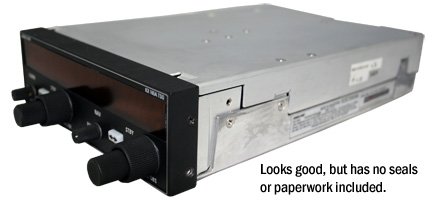
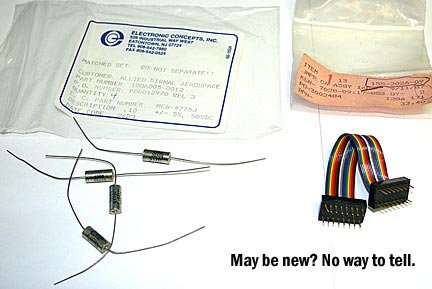
What other indicator can I use in place of my old KI-201C?
Unfortunately, there is not a current production VOR/LOC indicator that will directly replace the KI-201C. The KI-201C used a unique rectangular Winchester type connector. SEA recommends removing the KI-201C from the aircraft since it is no longer supported by Honeywell and is not repairable in most situations. Therefore, we recommend replacing the KI-201C with the KI-203 or KI-208. Although not direct replacements (i.e. connector change), the KI-203 and KI-208 provide a much more reliable indicator that is field repairable and still supported by Honeywell.
What is hidden damage and what does it mean to me?
The gas discharge display for my KY-197A is no longer available, what do I do?
The original gas discharge display (GDD) for the KY-197A has been phased out by Honeywell. A new display with LED technology is available for the KY-197A by way of Service Bulletin 9. The new LED provides a brighter, sharper display with longer life. SB 9 consists of replacing the display and one resistor, removing two resistors, and adding two wires.
Please note that the Service Bulletin mainly applies to KY-197A -30/-60 with S/N 15080 and below; and KY-197A -10/-11/-12/-31/-32 all serial numbers. Units will serial numbers above those stated have Mod 9 incorporated during original manufacturing.
Southeast Aerospace can update your KY-197A to the more reliable LED display. Pricing varies based on time and materials needed. For complete details, please contact Southeast Aerospace Tech Support at mro@seaerospace.com or complete a Repair Request at https://www.seaerospace.com/mro/repair-request
Does Southeast Aerospace offer a flat-rate upgrade to convert the MST-67A to -2101 status?
Yes, providing that the unit has been functioning normally, SEA can upgrade and convert the MST-67A transponder as follows:
MST-67A P/N 066-01143-0301 to 066-01143-2101 = $9550 USD
MST-67A P/N 066-01143-0601 to 066-01143-2101 = $9550 USD
MST-67A P/N 066-01143-1301 to 066-01143-2101 = $9550 USD
MST-67A P/N 066-01143-1602 to 066-01143-2101 = $6950 USD
Prices are subject to change should cost of parts needed change from OEM.
For a repair RMA or questions about any transponder service, please contact the SEA Repair Department.
Does Southeast Aerospace offer "Loaners"?
Southeast Aerospace does not believe that "Loaner" transactions offer any cost/time benefit to anybody. "Loaners" add unnecessary, wasteful, steps that are often overlooked.
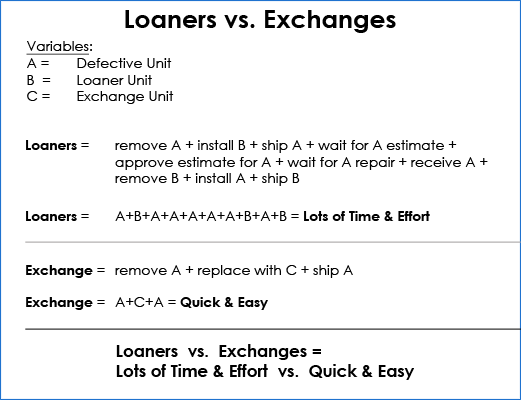
Southeast Aerospace's Exchange Program offers ready-to-ship, ready-to-install inventory very close to the price of average repair costs offered by other companies who offer Loaner units.
The Southeast Aerospace Exchange Policy is fair, clear, and concise. Contact SEA today for an Exchange Quote.
My KR-86 is not repairable and no longer supported, what can I replace it with?
Due to its unique integrated recever/indicator design, there is not a direct replacement for the KR-86 ADF. Southeast Aerospace recommends upgrading to the KR-87 ADF System. This is more or less a new installation. That is, all KR-86 wiring and cabling will need to be removed. The KR-87 receiver needs to be fitted in the larger KR-86 opening. Panel location for the KI-227 to be determined and the KA-44B replaces the KA-42B antenna on the aircraft.
What is meant by "FAA Accredited"?
FAA Advisory Circular 00-56A (or AC0056-A) describes a system of accreditation of civil aircraft parts for distributors. The original version of the Advisory Circular specifically mentions "brokers" and "resellers". This voluntary accreditation program simply provides suggestions and guidelines for a program to improve the validity of parts.
More or less, AC00-56A describes how a company can create an Accreditation Program by utilizing a third party quality system. Please see AC00-56A for a list of "Acceptable Quality System Standards".
AC00-56A very specifically indicates that the "FAA does not directly regulate distributors". Therefore, compliance of AA00-56A and/or third party accreditation does not in any way indicate, imply, or suggest any type of direct approval by the FAA. For example, an FAA Part 145 Certified Repair Station has direct approval and authorization to provide maintenance release certificates (ex. FAA Form 8130-3) and traceability for parts. "FAA Certified" agencies must meet and pass direct inspections, audits, and requirements set forth by specific FAA standards NOT by a third party quality organization.
Can the DA-1203A be overhauled?
If the DA-1203A is to be installed into a Eurocopter, according to the Eurocopter Service Bulletin (AS365 34.00.29), it is recommend that the unit be inspected per the Telephonics Service Letter (SL-T-08-0001, April 2008). The service letter has been incorporated into the current DA-1203A Maintenance Manual. The maintenance manual recommends that the unit be inspected for preventive maintenance every 3 years or 3000 hours whichever comes first.
SEA complies with the DA-1203A maintenance manual, and in turn complies with the inspection procedure cited in the Eurocopter Service Bulletin.
Why should I consider upgrading to the G series Proline II controls?
The original CTL-X2 controls are legacy controls with an original design almost 30 years old. As these controls age, support from Collins will be less and less. A common indicator of this decreasing support is the increase in price and decreasing availability of service parts to repair aging units.
What is the age of Collins Proline I?
Southeast Aerospace offers many affordable, upgradeable options that are available for aircraft with Collins Proline I. As avionics integration specialists and premiere Collins dealer, Southeast Aerospace is experienced and knowledgeable on all Collins Proline generations.
If you are interested in upgrading any of your original Collins Proline I systems, please contact us for the most reasonable, optimal choice available.
What is the age of the original King Gold Crown avionics line?
Most of the original Gold Crown products incorporate 1960s and 70s analog technology. As a result, most service parts needed to maintain and repair original King Gold Crown components are no longer available. Therefore, you will experience limited to no warranty available and unreliability for all of the original Gold Crown units.
Southeast Aerospace offers many affordable, upgradeable options for aircraft with original Gold Crown avionics. As avionics integration specialists and premier Honeywell Bendix/King dealer, Southeast Aerospace is experienced and knowledgeable on all Gold Crown generations.
If you are interested in upgrading any of your original Collins Gold Crown systems, then please contact us for the most reasonable, optimal choice available.
Why does SEA only offer 30 to 90 day warranty periods on certain avionics or instruments?
SEA does not find it possible, or practical, to offer longer warranty periods on these predetermined items.
SEA encourages our customers to choose newer technology that will be more efficient and effective for a long term solution. For help in determining an ideal solution for your situation, including budget and functionality, please feel free to contact SEA's sales department for knowledgeable and helpful assistance.
Why does SEA offer certain products for domestic sale only?
These particular items have been assessed with short-term warranty periods of 30 to 90 days due to limited repair possibilities. Most avionics with limited warranty periods are vintage items which were most often bulky and heavy by design. It is unfair to the customer to impose the typical high rates for international shipping of these items, while offering limited warranties, which most often suggest a short life of the unit.
SEA encourages our customers to choose newer technology that will be more efficient and effective for a long-term solution. For help in determining an ideal solution for your situation, including budget and functionality, please feel free to contact SEA's sales department for knowledgeable and helpful assistance.
What type of parts traceability does Southeast Aerospace provide?
Southeast Aerospace only utilizes factory obtained and factory traceable service parts for maintenance, repair, and overhaul functions. Factory documents including certificates of conformance (C of C) and packing slips are available for all service parts. New, finished good components sold by Southeast Aerospace include the same documentation.
In relation to used, serviceable, and overhauled components sold by Southeast Aerospace, traceability as per the FAA Repair Station Manual is provided. There is no FAA rule requiring "back to birth" traceability. This type of traceability in relation to certain products (especially legacy products) is not available nor necessary per the FAA guidelines. Maintenance procedures include requirements and provisions for work to be carried in such a manner as to return the product to an airworthy condition. Once the procedures are completed by an FAA approved source, traceability is validated and now originates from the last certified FAA source.
Why does SEA have special core requirements in relation to certain units?
Southeast Aerospace constantly reviews its exchange prices to prevent post-transaction billings to the customer as much as possible. In some cases, certain units include special conditions or circumstances that could result in higher than normal repair costs or render the unit uneconomical to repair. Southeast Aerospace informs customers of these special conditions up front before the transaction is processed, instead of letting the customer find out through excessive additional billing after the transaction.
Some examples of these special conditions on units may include the following:
- Damaged or modified units uneconomical to restore or reconfigure
- Defective, major component assemblies such as magnetrons, PA tubes, etc.
- Obsolete or unavailable service parts from the OEM
- Unsupportable or obsolete sub-assemblies
As part of our commitment to integrity, quality, and customer service your SEA associate will always inform you of any special core conditions before any exchange transaction is processed.
Why are exchange prices on EFIS indicators so high?
In most cases, SEA exchange prices reflect the assumption that the HVPS will need to be replaced in the defective unit. Based on SEA’s historical data, approximately 75% of defective EFIS indicators will need to have the HVPS replaced but not necessarily the CRT. However, in most cases where the CRT must be replaced, then the cost is more than a replacement unit thus rendering the defective unit beyond economical repair (BER).
What is required to replace the magnetron in an ART-2100?
According to Service Aid ART 2100-103 and ART-2100 maintenance manual, the unit must be altitude tested to 55000 feet after the magnetron is replaced. In addition, the AFC and STC curves need to be recalibrated over the temperature ranges of 25, -55, -30, -5, 45 and 70 degrees C.
Therefore, calibrated altitude and environmental chambers are needed for altitude and temperature testing mentioned above. Southeast Aerospace's Service Department is one of a very few authorized Honeywell service centers that possess and utilize the necessary chamber and facilities for this testing. Please contact our Service Dept for more details.
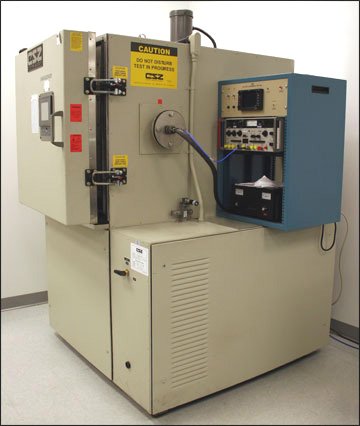
What is a Field Approval?
What is an FAA DAR?
- Manufacturing DARs must possess aeronautical knowledge, experience, and meet the qualification requirements of Order 8100.8.
- Maintenance DARs must hold:
- a mechanic's certificate with an airframe and power plant rating under 14 CFR part 65, Certification: Airmen Other Than Flight Crewmembers, or
- a repairman certificate and be employed at a repair station certificated under 14 CFR part 145, or an air carrier operating certificate holder with an FAA-approved continuous airworthiness program, and must meet the qualification requirements of Order 8100.8, Chapter 14.
Is the C406-2 / C406-2HM a direct replacement for the discontinued 110-406?
Yes, the C406-2 & C406-2HM ELTs are a direct replacement for the 110-406 Series. According to the Discontinuance letter released from Cobham, the 110-406 series product line was discontinued on 12/31/01. Artex planned to continue providing battery packs and repairs until 2008. You can view the letter here.
According to Artex (now Cobham) the C406-2/2HM ELTs are a direct replacement in form, fit & function. Additionally, the ME-406 series is suitable for General Aviation and Light Helicopter applications. These ELTs are certified to the requirements of FAA TSO C126 and ETSO-2C126.
View the C406-2, C406-2HM, and ME-406 Series product pages for more detailed information.
What is meant by condition AR?
The FAA describes parts of an unknown condition as "As Is". (Advisory Circular 20-62E). At some point in time, "As Removed" became an industry standard term in place of "As Is". Although the exact origin of the term "AR" is unknown, it may have originated from the fact that "As Is" implies some sort of "take it or leave it" or "you get what you get" situation. In some cases, units represented as "AR" may include documentation stating that the parts were removed from a particular aircraft and that they were not subject to an incident related aircraft. Although parts form these sources may be more reliable in some way or represented otherwise, they are still considered "As Is" or "As Removed" with an unknown condition. In all cases, these parts cannot be considered airworthy until they are deemed airworthy via an approved maintenance procedure by an authorized repair station.
Is "Serviceable" a term that is used on an FAA Form 8130-3 Return to Service?
- "Overhauled"
- "See Block 12"
- Repaired
- "Inspected" and/or "Tested"
- "Modified"
Block 11 is meant to reflect the majority of the "work performed" by the organization.
So, what is the term "Serviceable"?
Over the years, the aviation industry adapted the trade term "Serviceable" to imply a general "condition" of the unit. For sales purposes, Serviceable, more or less, differentiates between "Overhauled" parts and all other non-New parts that still included a Return to Service. The term "Serviceable" is widely used on many unofficial, non-FAA documents such as a company's quotes, invoices, or other related documents.
Are there any special considerations when interfacing a Collins DME-42 to the Garmin G1000?
What type of battery maintenance do the PS-835 series power supplies require?
What Federal Supply Classes (FSC) does Southeast Aerospace support?
Southeast Aerospace primarily provides Parts and Repair support in the following Federal Supply Classes:
- 5821 Airborne Radio and Television Communication Equipment
- 5826 Radio Navigation Equipment
- 5831 Airborne Intercom Systems
- 5841 Airborne Radar Equipment
- 5895 Miscellaneous Communication Equipment
- 5965 Headsets, Handsets, Microphones, and Speakers
- 5985 Antennas, Waveguides and Related Equipment
- 6605 Navigation Instruments
- 6610 Flight Instruments
What is the difference between BER and BPR when referring to parts?
BER is defined as Beyond Economical Repair. BER generally refers to when a repair item requires repair costs 75% or above the market value or procurement cost of the item.
BPR is defined as Beyond Physical Repair. BPR generally refers to a repair item that cannot be returned to service due to excessive damage or component obsolescene regardless of cost.
What does TTI mean in reference to parts?
TTI is an abbreviation used by some repair facilities to indicate the Test, Teardown, and Inspection process and/or cost for a component.
Some other related terms may include:
- Bench Test
- Bench Check
- Evaluation
Where can I send my Icom radio for repair?
For Icom aviation radios, there are currently (2018) three service centers that can repair the radios. Please see this link for information: http://www.icomamerica.com/en/support/repair/default.aspx
When did Garmin discontinue support for the GPS-155XL, GNC-250XL, and GNC-300XL?
Garmin issued Service Advisory No. 1930 Rev B on August 13, 2020 which stated that repair services and service parts were discontinued for the GPS-155XL, GNC-250XL, and GNC-300XL units.
What do the condition abbreviations indicate in aviation?
The aviation parts industry uses abbreviations and terminology to designate and describe the status or condition for a component. They usually apply to finished goods or complete assemblies.
It should be noted that these conditions and descriptions can be misused at times and parts misrepresented for sales and marketing purposes. There are legitimate, documentable methods for properly representing the condition of a part in the aviation industry. Many descriptions follow specific regulatory agency guidelines. Therefore, this article is not intended to address every condition scenario or status for describing a part. However, it will describe the following condition codes - NE, AR, SV, OH - which are more or less universally accepted by legitimate entities in the aviation industry.
- NE
- Abbreviation for "New". The word "new" can carry different meanings and implications. In sales, statements such as "looks like new" or "like new" may be used to describe something. However, in aviation, truly "New" parts will be accompanied with substantiating documents such as Certificate of Conformance or FAA Form 8130 in addition to the item appearing to be unused. The abbreviation "FN" or Factory New is used by some in the industry. Ultimately, it should imply the same details as condition NE. That is, the part is in the same condition as it was manufactured, packaged, shipped and received from the original manufacturer (i.e. factory).
New Surplus or "NS" condition is used by some to represent what they believe to be New, unused parts. For the most part, New Surplus is a trade term that is not officially recognized by most if not all regulatory agencies. Likewise, New Surplus is a loosely used term by some parts suppliers to describe items that may visually appear to be new and unused but have no documentation or certification to support the claim. Therefore, in most cases where items do not have traceability or proof of condition, such items should be considered "As Removed" (more to follow in relation to this condition). - OH
- The FAA describes OH as "Overhauled". This describes an airframe, engine, or component part using methods, techniques, and practices which has undergone the following: (1) disassembled, cleaned, inspected, repaired when necessary, and reassembled to the extent possible, (2) tested in accordance with approved standards and technical data (i.e., manufacturer's data). This is a condensed description of the FAA guidelines relating to "Overhauled".
OH, Overhauled, OHC and Overhauled Condition are widely used and are defined in different ways depending on the sector of aviation. Most broadly, overhauling a part refers to the inspection and cleaning as defined by Federal Air Regulation Part 43.2. The FAA mandates that certified repair stations not only follow any prescribed overhaul procedures specified in a component maintenance manual but also inspect and verify that all mandatory service bulletins and airworthiness directives are complied with if applicable. In addition, when certifying a unit as overhauled, the repair station must verify and validate that all modifications and/or service bulletins marked on the mod chart or dataplate of the unit are incorporated in the unit. Likewise, most repair stations improve cosmetics and overall appearances of unit they may be certifying as overhauled since this is often included in the cleaning and inspection procedures.
Like other conditions, OH is sometimes used as a means to enhance a parts advertisement's sales or marketing potential. That is, someone may simply make a unit appear to be overhauled by cosmetically improving the outside of the unit while the aspects of a true overhaul (inspection, disassembly, cleaning, etc.) may have not been performed internally. - SV
- SV or SVC is an abbreviation for "Serviceable". Over the years, the aviation industry adapted the trade term Serviceable to imply the general functional condition of a unit. For sales purposes, Serviceable, more or less, differentiates between Overhauled parts and all other non-New parts that still include a Return to Service or Maintenance Release. The most common are the FAA Form 8130 and EASA Form 1. On these forms, Serviceable is usually indicated as "Inspected", "Repaired", or "Modified". All of these terms imply that some type of inspection or test was performed at the very least. In addition, the work was performed according to a documented, up-to-date procedure in regulatory agency approved technical publication(s) or data. The approved publication or data is indicated on the Return to Service or Release document.
Other statements may be encountered that imply serviceability such as "Serviceable When Removed", "Removed Serviceable" and "Working When Removed". These are trade terms not recognized by most regulatory agencies. They should simply be considered a general statement of opinion until specific test and inspection procedures are performed by an approved source.
Special Note: In reference to NE, OH and SV certified parts, other factors should be considered such as the date of certification, storage environment, and shelf life. These factors can ultimately affect the serviceability and functionality of a part also.) - AR
- An abbreviation for "As Removed". Most likely, the introduction and usage of this term was meant to describe the condition of a component at the time it was removed from the aircraft for a certain reason. Over the years, AR condition has become a catch-all status for any used part that does not include a Maintenance Release or Return to Service document. This could include parts represented as Repairable (RP), parts known to be defective at time of removal from the aircraft, parts that were partially or unsuccessfully repaired, parts not able to be economically repaired and even cannibalized parts in some cases. However, most legitimate parts sources use the AR term to describe a part that was removed from an airworthy aircraft in an economically repairable condition. When a part has been deemed uneconomical to repair compared to the cost of a functional replacement then the term "Beyond Economical Repair" (BER) is often used. Ultimately, it is recommended that buyers of parts should consider the term As Removed to represent a part with an unknown condition or functional status.
Why is the GMA-340 audio panel no longer available?
When did Garmin stop supporting the 28 Volt versions of the GNS-430/530 series units?
According to Garmin Support Memo dated July 21, 2010, effective September 30, 2010, the 28 Volt only versions of the GNS-430/530 series units will no longer be repaired due to parts availability issues.
The 28 Volt only versions of the GNS series units are the very first original productions units from the late 1990s.
Does L3 still support the A100 and A100A CVRs?
L3 no longer provides repair service or parts support for mechanical CVRs and FDRs. This is detailed in L3 Service Information Letter L3AP-007.
Please contact Southeast Aerospace for questions or further details.
What does “Memory Status Bad 12345ABC” mean?
The ETM has lost the configuration settings in the internal memory. The ETM processor will need to be returned to our FAA Repair Station for service.
What are some of the differences between the GTN-650/750 and GTN-650Xi/750Xi
The GTN Xi navigators provide several improvements over the original GTN navigators including a dual processor and updated LCD screen.
The upgraded processor enables the Xi to be faster than the original GTN. The updated screen improves the resolution from 134 DPI to 187 DPI.
Some of the other minor differences include:
- Location of buttons on the Xi were moved closer to the bottom right knob
- All databases stored internally on the Xi
- The Xi is lighter in weight
- The Xi draws less current
In relation to ELTs, what is the difference between short messaging and long messaging?
Long messaging transmits longtitude and latitude. Short messaging does not.
What products included in Garmin's Dealer Installation Policy for 2022?
Dealers are required to install and service most New Products purchased from Garmin. This applies to Factory New Garmin equipment purchased by a dealer from Garmin. Dealers may sell Garmin products over-the-counter (without dealer installation) in SV or OH condition.
As of 2022, the following Garmin products apply to this Installation Policy:
- G500 TXi series
- G600 TXi series
- G700 TXi series
- G500H TXi
- GAD 43
- GAD 43e
- GAD 42
- G3X Touch Certified
- GRA 55/5500
- GNX 375
- GSR 56
- GTN 625/635/650 Xi
- GTN 750 Xi Series
- GTS Series
- EIS TXi
- GTX 3000
- GTX 345 series
- GTX 335 (excludes K10 PN kit)
- GTX 32
- GTX 330
- GWX 70/75 series
- GWX 8000
- GI 275 (AHRS, AP or IVSI versions)
- Flightstream 110/210/510
- Retrofit Integrated Flight Decks
- GMA 35/350
- GDL 84/88
- GDL 69
- GFC 500 series
- GFC 600 series
- GFC 500H series
- GEA 110/71
What do the condition abbreviations indicate in aviation?
The aviation parts industry uses abbreviations and terminology to designate and describe the status or condition for a component. They usually apply to finished goods or complete assemblies.
It should be noted that these conditions and descriptions can be misused at times and parts misrepresented for sales and marketing purposes. There are legitimate, documentable methods for properly representing the condition of a part in the aviation industry. Many descriptions follow specific regulatory agency guidelines. Therefore, this article is not intended to address every condition scenario or status for describing a part. However, it will describe the following condition codes - NE, AR, SV, OH - which are more or less universally accepted by legitimate entities in the aviation industry.
- NE
- Abbreviation for "New". The word "new" can carry different meanings and implications. In sales, statements such as "looks like new" or "like new" may be used to describe something. However, in aviation, truly "New" parts will be accompanied with substantiating documents such as Certificate of Conformance or FAA Form 8130 in addition to the item appearing to be unused. The abbreviation "FN" or Factory New is used by some in the industry. Ultimately, it should imply the same details as condition NE. That is, the part is in the same condition as it was manufactured, packaged, shipped and received from the original manufacturer (i.e. factory).
New Surplus or "NS" condition is used by some to represent what they believe to be New, unused parts. For the most part, New Surplus is a trade term that is not officially recognized by most if not all regulatory agencies. Likewise, New Surplus is a loosely used term by some parts suppliers to describe items that may visually appear to be new and unused but have no documentation or certification to support the claim. Therefore, in most cases where items do not have traceability or proof of condition, such items should be considered "As Removed" (more to follow in relation to this condition). - OH
- The FAA describes OH as "Overhauled". This describes an airframe, engine, or component part using methods, techniques, and practices which has undergone the following: (1) disassembled, cleaned, inspected, repaired when necessary, and reassembled to the extent possible, (2) tested in accordance with approved standards and technical data (i.e., manufacturer's data). This is a condensed description of the FAA guidelines relating to "Overhauled".
OH, Overhauled, OHC and Overhauled Condition are widely used and are defined in different ways depending on the sector of aviation. Most broadly, overhauling a part refers to the inspection and cleaning as defined by Federal Air Regulation Part 43.2. The FAA mandates that certified repair stations not only follow any prescribed overhaul procedures specified in a component maintenance manual but also inspect and verify that all mandatory service bulletins and airworthiness directives are complied with if applicable. In addition, when certifying a unit as overhauled, the repair station must verify and validate that all modifications and/or service bulletins marked on the mod chart or dataplate of the unit are incorporated in the unit. Likewise, most repair stations improve cosmetics and overall appearances of unit they may be certifying as overhauled since this is often included in the cleaning and inspection procedures.
Like other conditions, OH is sometimes used as a means to enhance a parts advertisement's sales or marketing potential. That is, someone may simply make a unit appear to be overhauled by cosmetically improving the outside of the unit while the aspects of a true overhaul (inspection, disassembly, cleaning, etc.) may have not been performed internally. - SV
- SV or SVC is an abbreviation for "Serviceable". Over the years, the aviation industry adapted the trade term Serviceable to imply the general functional condition of a unit. For sales purposes, Serviceable, more or less, differentiates between Overhauled parts and all other non-New parts that still include a Return to Service or Maintenance Release. The most common are the FAA Form 8130 and EASA Form 1. On these forms, Serviceable is usually indicated as "Inspected", "Repaired", or "Modified". All of these terms imply that some type of inspection or test was performed at the very least. In addition, the work was performed according to a documented, up-to-date procedure in regulatory agency approved technical publication(s) or data. The approved publication or data is indicated on the Return to Service or Release document.
Other statements may be encountered that imply serviceability such as "Serviceable When Removed", "Removed Serviceable" and "Working When Removed". These are trade terms not recognized by most regulatory agencies. They should simply be considered a general statement of opinion until specific test and inspection procedures are performed by an approved source.
Special Note: In reference to NE, OH and SV certified parts, other factors should be considered such as the date of certification, storage environment, and shelf life. These factors can ultimately affect the serviceability and functionality of a part also.) - AR
- An abbreviation for "As Removed". Most likely, the introduction and usage of this term was meant to describe the condition of a component at the time it was removed from the aircraft for a certain reason. Over the years, AR condition has become a catch-all status for any used part that does not include a Maintenance Release or Return to Service document. This could include parts represented as Repairable (RP), parts known to be defective at time of removal from the aircraft, parts that were partially or unsuccessfully repaired, parts not able to be economically repaired and even cannibalized parts in some cases. However, most legitimate parts sources use the AR term to describe a part that was removed from an airworthy aircraft in an economically repairable condition. When a part has been deemed uneconomical to repair compared to the cost of a functional replacement then the term "Beyond Economical Repair" (BER) is often used. Ultimately, it is recommended that buyers of parts should consider the term As Removed to represent a part with an unknown condition or functional status.
What is a NAICS code?
The North American Industry Classification System or NAICS is a system of classifying business by industry developed in cooperation with Canada and Mexico. It is a standard used by federal agencies for classification purposes. Businesses are classified into a six-digit NAICS code number based on the activity of the business. Businesses can be classified under multiple NAICS codes.
Southeast Aerospace provides products and services under the following NAICS codes:
- 334290
- 334511
- 335999
- 336411
- 336413
- 423690
- 423860
- 488190
- 541330
What version of the Garmin GI-275 is required for Primary ADI?
In order for the GI-275 to be the approved primary attitude indicator for an aircraft on the STC Approved Model List, the ADAHRS version of the GI-275 must be purchased.
How is SB1000 indicated on new production ACR/Artex ELTs?
The only indication that new ACR/Artex ELTs have the upgraded G-switch as detailed in SB1000 is the "UPGRADED G-SWITCH" box on the identification plate. Please see image for reference.
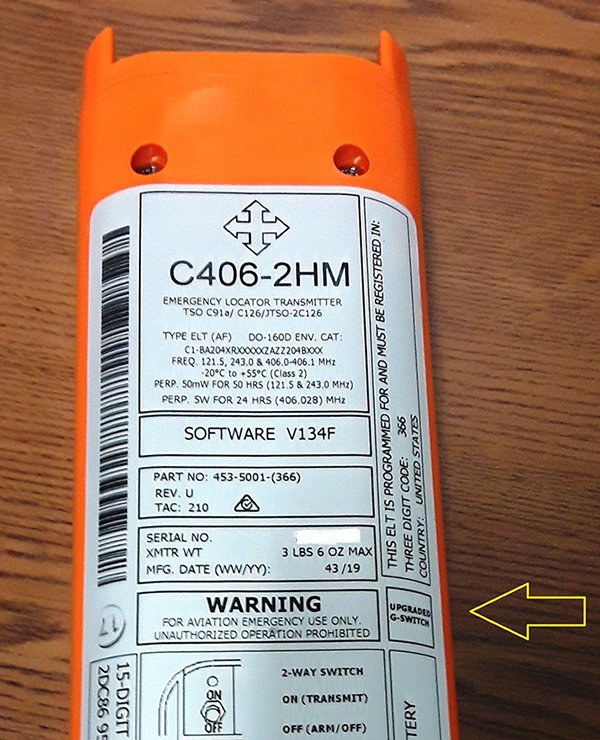
How can I safely clean and disinfect my Garmin avionics?
Garmin has provided Service Advisory 2051 for general recommendations, materials, and supplies to clean and disinfect Garmin products. Otherwise, not following the recommendations could void the warranty.
- Cleaners containing ammonia will harm the anti-reflective coating on many Garmin aviation display lenses.
- Disinfectant with a solution of 70% isopropyl alcohol that does not contain ammonia is preferred. Solutions of up to 91% isopropyl alcohol are also acceptable.
- Clean the display lens using a clean lint-free cloth and a cleaner that is specified as safe for anti-reflective coatings.
- For other exposed surfaces such as knobs, buttons, and bezels, a damp cloth with soap and water is acceptable.
- Bleach-based cleaners, ammonia-based cleaners, or other harsh chemicals on any surface are not recommended.
- Remove all soap/soap residue to prevent buttons and knobs from gumming up or becoming slippery.
- Many aviation products are not rated as waterproof. Spraying or wetting the units to the extent where moisture could go beyond the exterior surfaces could damage the unit.
What is the difference between Garmin GTX-335 part numbers K10-00276-03 and K10-00276-04?
Both are Garmin kit part numbers for the GTX-335 ADS-B panel mount transponder with internatl WAAS GPS that can be sold over-the-counter without dealer installation.
Both include the transponder w/ WAAS, GA-35 antenna, STC product registration, installation kit, and pilot's guide.
PN K10-00276-04 additionally includes the GAE-12 altitude encoder and high-speed multi-charger.
What is the ADS-B mandate for Europe?
ADS-B Out takes affect in Europe on June 7, 2020. The mandate only applies to aircraft with a Maximum Take-Off Weight (MTOW) more than 5700 kg (12566 pounds) or with a maximum cruising speed more than 250 knots.
What is AHARS or AHRS?
AHARS or AHRS is an abbreviation for Attitude and Heading Reference System. An AHARS/AHRS unit normally consists of solid-sate sensors that provide attitude, heading, roll, pitch, and yaw for an aircraft. AHARS/AHRS was designed to replace legacy mechanical gyroscopic flight instruments due to higher reliability. AHARS/AHRS may be combined with an air data computer to produce ADAHRS to provide other data such as airspeed, altitude and OAT (outside air temperature).
Is the GTX-325 a direct replacement for the GTX-327?
No. While the GTX-325 is a Mode C transponder replacement for the Mode C GTX-327, they have different connectors. The GTX-325 uses a 62 pin high-density connector while the GTX-327 has a standard 25 pin D-sub type connector.
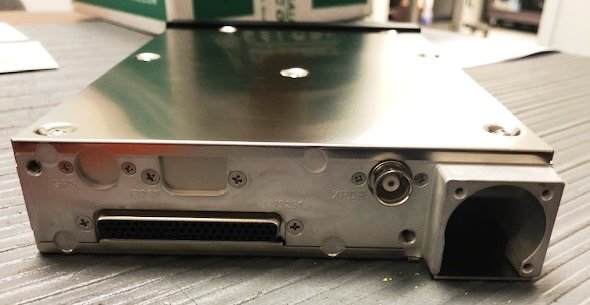
Is the BendixKing KI-300 Indicator available for over-the-counter sale without dealer installation required?
Yes, the KI-300 attitude indicator by itself is available for over-the-counter sale. However, if the KI-300 with KA-310 autopilot adapter option is desired, Southeast Aerospace recommends that you contact your local BendixKing dealer for purchase and installation.
What features do the -501/502/551/552 versions of the TDR-94/94D have?
The -501/-502/-551/-552 versions of the TDR-94/94D comply with DO-260B (V2) standard for ADS-B Out. The -501/-502 is applicable to fixed wing aircraft while the -551/-552 is applicable to rotary wing aircraft. Service bulletin upgrades and exchanges are available to bring select TDR-94/94D transponders to DO-260B statuses.
Is it possible to upgrade a -006 or older TDR-94 / 94D for ADS-B compliance?
According to Collins' ADS-B Out Pricing Guide, it is not economical to upgrade a -006 or below TDR-94 or -94D. A replacement unit with a PN that meets ADS-B requirements should be installed.
What does SCN stand for in relation to Universal Avionics?
Software Control Number
What is unique about the TDR-94/94D -502 version?
Why is the core charge for my exchange transaction on my Commercial Invoice?
Exchange core values should be indicated on all invoices. Per US customs regulations, the value of the unit must be indicated on a Commercial Invoice, not the value of the transaction. Both the invoice and Customs Invoice must match. The following excerpt is from the Department of Commerce Foreign Trade Regulations:
Section 30.1
Export value: The value of the goods at the U.S. port of export. The value shall be the selling price (or the cost if the goods are not sold), including inland or domestic freight, insurance, and other charges to the U.S. seaport, airport, or land border port of export. Cost of goods is the sum of expenses incurred in the USPPI's acquisition or production of the goods. (See § 30.6(a)(17)).
Section 30.6(a)(17)
In general, the value to be reported in the EEI shall be the value of the goods at the U.S. port of export. The value shall be the selling price as defined in this paragraph (or the cost if the goods are not sold), including inland or domestic freight, insurance, and other charges to the U.S. seaport, airport, or land border port of export. Cost of goods is the sum of expenses incurred in the USPPI acquisition or production of the goods. Report the value to the nearest dollar; omit cents. Fractions of a dollar less than 50 cents should be ignored, and fractions of 50 cents or more should be rounded up to the next dollar. (i) Selling price. The selling price for goods exported pursuant to sale, and the value to be reported in the EEI, is the USPPI's price to the FPPI (the foreign buyer). Deduct from the selling price any unconditional discounts, but do not deduct discounts that are conditional upon a particular act or performance on the part of the foreign buyer. For goods shipped on consignment without a sale actually having been made at the time of export, the selling price to be reported in the EEI is the market value at the time of export at the U.S. port.
Are there any replacements for the KA-61 antenna?
On May 23, 2018, BendixKing announced the KA-61A as a replacement for the KA-61. Since it has a BNC connector, it is only a direct replacement for the KA-61 PN 071-00221-0010.
What does AOG mean?
Aircraft On Ground or AOG is a term used in aviation indicating that a problem exists that prevents an aircraft from flying. It implies a heightened urgency to acquire parts or service to allow the aircraft to be put back into service and prevent further delays.
What is meant by New Surplus (NS) condition?
Per the FAA, "Surplus" is described as "a product, assembly, part, or material that has been released as surplus by the military, manufacturers, owners/operators, repair facilities, or any other parts supplier. These products should show traceability to an FAA-approved manufacturing procedure."
"New Surplus" is a trade or industry specific term that is not officially recognized by the FAA. Unfortunately, "New Surplus" is a loosely used term by some parts supplier to describe items that may appear to be new and unused but have no documentation or certification to support the claim. Therefore, in most cases where items do not have traceability or proof of condition, such items are be considered "As Is" or "As Removed".
In FAA Advisory Circular AC20-62E, it is further explained that surplus items "although advertised as "remanufactured," "high quality," "like new," "unused," or "looks good," should be carefully evaluated before they are purchased. The storage time, storage conditions, or shelf life of surplus parts and materials are not usually known." "New Surplus" is not an acceptable term to be input into any maintenance release such as the FAA Form 8130-3 according FAA Order 8130.21G.
In most transactions, Southeast Aerospace does not consider "New Surplus" a valid condition term. Southeast Aerospace will not consider any unit as "New" condition without exact traceability, documentation, and history for a unit from the Original Equipment Manufacturer (OEM). Otherwise, Southeast Aerospace considers any unit lacking appropriate OEM paperwork as "As Removed" and thus will require recertification.
Once any item regardless of condition is tested and certified according to manufacturer's specifications, it is considered "Inspected", "Repaired", or "Overhauled" depending on the work performed during the certification process.


Are SEA's Exchange prices negotiable?
Negotiating the exchange price of a unit only limits the allowable repair cap for the core unit. Southeast Aerospace's exchange transactions are based on the return of economically repairable core unit. Once the core is received and evaluated, the core repair cost incurred by SEA cannot exceed 75% of the original exchange price. That is, it cannot cost SEA more than 75% of the original OH/SV exchange price collected from the customer. Therefore, when and if an SEA exchange price is discounted, there is a risk that additional charges may be assessed once the core is returned and evaluated.
What is the difference between Garmin part numbers beginning with 010 and 011?
Garmin part numbers beginning with 010 are used by Garmin to identify products as "Shipping Level Part Numbers", Catalog or Kit part numbers. 010 type part numbers do not appear on the actual dataplate for almost all Garmin aviation units.
Garmin part numbers beginning with 011 are the actual unit part numbers, meaning the 011 part numbers are on the dataplate and paperwork of the unit. In most cases, related system accessories within the 010 standard kit and 010 catalog p/n with install kit do have individual 011 part numbers, but are ordered with the single 010 part number that designates a complete kit.
What are the shelf life guidelines for various avionics products?
There are several categories of equipments used in determining shelf life for avionics. Shelf life refers to the amount of time that an avionics unit can remain in storage and still be expected to perform to specifications. Shelf life suggestions assume that a unit is controlled and maintained in environment where humidity is less than 60%, temperature is 68 deg. F +- 10, and in the absence of noncorrosive contaminants.
The categories are based on equipment intricacy, type and quantity of mechanical parts, and other factors such as lubrication, etc.
According to the Rockwell Collins Instruction Book for Avionics Standard Shop Practices, the longest shelf life period should be 5 years. This pertains to the least complex equipment such as mounts that only require visual inspection after 5 years to recertify.
For other, more complex equipment the following shelf life guidelines should be followed:
| Air Data Computers | 24 Months |
| Altimeters | 12 Months |
| Computers | 24 Months |
| Control Panels | 24 Months |
| EFIS Displays | 12 Months (applies to any unit with CRT) |
| Gyro | 12 Months (any unit w/ gears, bearings, etc) |
| Indicators | 12 Months (units w/ meter movements) |
| Radios | 24 Months |
| Radio Altimeters | 24 Months |
| Sensors (analog) | 12-18 Months |
| Sensors (digital) | 24 Months |
| Servo | 12 Months (any unit w/ gears, bearings, etc) |
| Transponders | 24 Months |
Most avionics manufacturers advise that units should be recertified per performance tests in the applicable manual by the end of the shelf life period.
How does Southeast Aerospace process "Exchange" transactions?
"Exchange" is a term used in aviation and most other parts industries to indicate the exchange of a known defective or unserviceable unit for a known good, serviceable unit. In most cases, in simple terms, exchanges are sought after when quick replacement of a defective unit is needed.
Southeast Aerospace's exchange price is based on a standard exchange. Additional billing will only occur if the cost to repair the core received exceeds the repair cap. The "repair cap" is the maximum allowable cost to repair the customer core. If the cost to repair the core exceeds the repair cap, the customer will be billed an additional fee equaling the difference between the repair cost and the repair cap. If the additional fee exceeds or equals the core charge, the core will be deemed to be beyond economical repair and the core will be billed back to the customer at the original stated core charge amount indicated on the exchange invoice. A billback of the original core charge amount will also occur in the vent that a core is not returned.
A standard exchange is only valid with the return of an economically repairable, normal core of the same model and same part number. A definition of a normal, repairable core is a unit that has experienced a normal equipment failure not related to an incident (i.e. fire, water damage, or act of nature) or improper installation. Units that have been heavily modified or extensively, unproductively worked on are not accepted as exchange cores. In rare cases or situations, exchanges may be conditional based on the serial number or service bulletin threshold of a unit due to certain older units not being supported by the manufacturer.
Click on a question below to see the answer. Please note, as more questions are answered, this document will be updated to include them.
Check back often for even more ADS-B information.
Need ADS-B Help?
I have a Garmin GTX-327 transponder and GNS-430 Non-WAAS. I am considering the FreeFlight RANGR Lite. Is this a good option?
Yes, the RANGR Lite is meant for owner/operators who do not have an ES (Extended Squitter) upgradeable transponder or WAAS GPS in their aircraft. The less expensive unit (TXL) is Transmit only while the other (XVRL) includes ADS-B In as well which will display (traffic and weather) on the GNS-430 but would be need to be interfaced.
I want to upgrade my PA24-260 Piper Comanche nav/com to a GNS-530W as well as making it ADS-B in/out compliant. What transponder and other components are required?
First, we would recommend contacting a local Garmin dealer to discuss the following:
- Upgrading your existing nav/com to a used GNS-530W or the newer GTN-750.
- If you already have a Garmin transponder (i.e. GTX-330), then you should simply get the ES upgrade, interface to GNS-530W or GTN-750, along with a few other minor installation considerations, and get the shop to do the appropriate paperwork based on Garmin's AML STC.
- If you do not have the GTX-330, then you should just consider pursuing one of the GDL systems from Garmin. Most likely the GDL88 which will give you In/Out capability. Same interface and installation considerations as above apply. Please note ADS-B In is not required for the mandate.
On our L410 aircrafts are installed Mode S Transponders MST 67A p/n 066-01143-2101, GTX 330D p/n 011-00455-10 and GTX 330 p/n 011-00455-00. Please advise me what we can do to comply with ADS-B requirements?
UPDATE
5/9/2018
Bendix/King, L3 and ACSS released the NXT-700/MST-70B as form fit replacement for the MST-67A. It is DO-260B compliant to meet the ADS-B Out mandate.
There are other options besides the MST-70B to gain ADS-B compliance. There are various STCs that allow the removal of the Bendix/King transponder system and installation of Rockwell Collins or Garmin transponders. Upgrade prices vary depending on actual installed equipment.
Regarding ADS-B for the Garmin GTX-330 transponders, the best solution is to simply have the units converted by Garmin to include the ES (Extended Squitter) upgrade. This upgrade is about $2000 approximately. Additionally, a WAAS/GPS source will need to be interfaced. We can process the upgrade for you or any other Garmin dealer can as well.
After I have my Garmin GTX-330 upgraded for Extended Squitter (ES), how do I install it?
First, please reference the information Garmin provides in relation to the ES upgrade:
http://www.garmin.com/us/intheair/ads-b/seven-questions/
There is perhaps a misconception that simply having your Garmin GTX-330 transponder upgraded to include Extended Squitter capability is the only step for ADS-B Out compliance. As with almost all ADS-B installations, appropriate interfacing to other systems in the aircraft (ex. approved position source & altitude source) is required along with approved guidance material that indicates the airworthiness approval procedure followed for return to service of the aircraft (ex. AML STC). Garmin provides an Installation Manual with Approved Model List STC for its Aviation dealers. Authorized dealers should not be distributing the necessary data and paperwork for the ADS-B installation to non-dealers.
As with all ADS-B installations, Southeast Aerospace strongly recommends that you only contact and consult a trained, authorized avionics dealer.
Anyone can do an ADS-B installation right? How difficult could it be?
No. Southeast Aerospace strongly recommends that you only contact and consult a trained, authorized avionics dealer for all ADS-B installations.
One of the reasons for much of the confusion, controversy, and misinformation surrounding ADS-B is due to those in the aviation realm who are minimalizing or ignoring key aspects of an ADS-B installation. Most if not all ADS-B installations are not a “box-swap” regardless of any advertising or information on the Internet stating as much. Even if you were to seek alternate, unauthorized methods to obtain ADS-B equipment or upgrades to existing equipment, you still need a way to get it in the aircraft and approved by the FAA. Most ADS-B product manufacturers only offer AML STCs they have to authorized dealers in their network.
If you want to be compliant and able to fly in 2020, then just get the job done right the first time. Unfortunately, some people in aviation always try to cut corners on avionics installations by underestimating the job at hand in hopes to save a buck. It never works out to your advantage no matter how it looks on the bottom line on the frontend of the job. The old saying holds true for ADS-B installations especially – “Pay Now or Pay Later”.
If you want your installation done right the first time legally and technically, then contact a trusted avionics shop that has formal training on ADS-B and the related products from the OEM. Or, contact the OEM and ask for a recommendation in your area. Most OEMs are more than happy to refer to a legitimate, quality dealer in your area.
I need to update with ADS-B, at least Out, two planes and I´d appreciate your assistance.
Citation S550 equipped with: Transponders MST-67A 066-01143-2101. Chance to update to ES?
Garmin GPS400. Chance to update software to WAAS? Or maybe to replace with a GPS400W and link it with transponders? - FMS UNS-1L SCN 803.1. Citation Mustang C510 equipped with G1000 Integrated Flight Deck. It is a 2008 plane.
What can I do to get ADS-B at an affordable price?
A: Since the aircraft are operated in Spain, what region or ADS-B spec do you need to meet? (i.e. USA, DO-260B?)
Without knowing exactly what ADS-B requirement or mandate you might be trying to comply with, I can only provide information relative to what we know here in the USA in reference to ADS-B for Part 25 aircraft.
For the Citation 550, the MST-67A will be superseded by the MST-100B if/when Honeywell can produce and certify the MST-100B. I have attached the only details that we currently have on the MST-100B. Honeywell has not even released pricing on this unit yet, however, ideally it would be an ideal solution ultimately since it is said to be plug and play with the MST-67A. With a WAAS GPS interfaced it would meet all ADS-B mandates. Also, keep in mind, that your CAS-67 can be upgraded fairly easily to Change 7.1 via Honeywell sales bulletin upgrading the TPU-67A processor to the TPU-67B. There is a company that offers some STCs for Part 25 aircraft if your region requires an STC for the 7.1 upgrade - http://www.prostaraviation.com/
If the MST-100B does not pan out for some reason and/or Honeywell keeps delaying its release, then there is a company named Jettech that has released Garmin GTX 3000ES ADS-B capable transponder to its existing STC covering Garmin GTN install on Citation and Citation Jet aircraft equipped with TCAS II. In addition, the company amended its Garmin GTN autopilot coupled LPV FAA STC for the Citation 500 series to include all Primus 1000 equipped Bravo, Ultra, Encore and Excel aircraft. They do not have much information on their website about the ADS-B STC but I recently learned about it at the AEA convention last week - http://jettechllc.net/index.html
Regardless of what direction you might go in, you should most likely get your GPS-400 upgraded to the GPS-400W while Garmin is still offering the upgrade. It is relatively inexpensive at around $3000 USD. Most FANS type systems will require WAAS GPS input or accuracy ultimately. Plus, Garmin's WAAS interface tis very compatible with most ADS-B solutions. Regarding the Citation Mustang C510 equipped with G1000, Garmin is still working on this solution. We assume it will include the GTX-3000 transponder(s) as this aircraft will require a 1090 MHz, (not 978 MHz UAT) system. I would continue to monitor Garmin's website for announcements relating to the G1000.
The helicopter has a Garmin 530 COM/NAV/GPS, Ryan 9900BX TCAD tied into Garmin GTX327 Transponder. Will this Meet ADS-B?
In most cases, if you already have Garmin equipment, the easiest route to comply with ADS-B is to stay with Garmin. Based on what you gave me below, you would need to upgrade your GNS530 to the 530W (WAAS) and replace your GTX327 with the GTX330ES (Extended Squitter). Most shops will give you a trade-in value for the GTX327 and there are some used GTX330ES units out there on the market. This route will make you compliant with the 1090ES part of ADS-B compliance.
Otherwise, if you choose to keep the GTX327 and go with the GDL88 or GDL84 UAT (978 compliance), you will still have to get your GNS530 upgraded to WAAS and then handle some additional considerations.
I have a Bendix/King KMD150 GPS will this work with the new King KGX 150 ADS-B to make me 2020 compliant with FAA?
Unfortunately, the GPS in the KMD-150 does not comply with any of the requirements for GPS performance in the latest ADS-B mandate or DO-260B. More or less, although it is not specifically referred as such, current WAAS GPS receivers are the only GPS receivers that meet the performance requirement needed for ADS-B Out.
Considering your current situation, here are a few possible scenarios for you to comply:
- Keep the KMD-150 with GPS as a stand-alone navigation aid and pursue the KGX-150 with internal GPS. This would of course require installing a separate WAAS GPS antenna on your aircraft for the KGX-150. In addition, you would not receive any of the ADS-B In benefits since the KMD-150 is not an interface for that. However, there are many options to display ADS-B In information on anything from smartphones, tablets, etc.
- Replace the KMD-150 with some sort of Garmin GNS or GTN navigator which will meet the approved position source requirements for ADS-B. I would recommend their GDL-84 or 88 boxes for the UAT portion of the equation however there are a few other manufacturers offering less expensive UAT solutions like Free Flight with their Ranger Lite product.
The second option is obviously going to be more expensive but gives you a little more versatility and more capability in your aircraft. I only included UAT (978) options because I am assuming that you are flying below 18,000 feet.
Our aircraft is equipped with a Bendix/King KT-76C transponder. The aircraft is not equipped with a GPS receiver. We are considering having a Bendix/King KGX 150 unit installed to meet the 2020 ADS-B equipage mandate.
A few questions related to the KGX 150 :
- Can this unit be paired with the KT-76C transponder?
- What will the Wi-Fi option cost?
- With our configuration, what antennas will need to be installed to meet the ADSB-Out requirements?
- Will an additional antenna be required to facilitate ADS-B-In?
There are a few things to be aware of with all UAT installations. These units require a control device and a switch to place them in air/ground mode. The switch is not a major issue and is a minor cost. However, the controller is additional if the aircraft is not already equipped with a transponder and/or display (MX20 for example).
As you’ll see below, yes, the KT-76C will pair with the unit via the antennas. Basically the UAT will sense the XPDR. This will enable you to send the Mode A and IDENT information to the UAT unit. However, you are still required per the FAA to have a way to know your ADS-B status. If a suitable display such as the Garmin MX20, Aspen EFD1000 or the KSN 770 is not installed, then a remote control unit is required. The KGX Control Panel list price is currently $619. Depending on the aircraft and the kind of flying, there are a lot of factors and options to consider.
- Can this unit be paired with the KT-76C transponder?
- Yes
- What will the Wi-Fi option cost?
- The Wi-Fi option will run around $349 list for parts.
- With our configuration, what antennas will need to be installed to meet the ADS-B-Out requirements?
- Per the STC, you will be required one external WAAS/GPS antenna and at least one UAT antenna.
- Will an additional antenna be required to facilitate ADS-B-In?
- No, as long as the unit purchased is the transceiver. However, you will need a suitable display for the "In" without the Wi-Fi.
Due to the 2020 requirement for ADS-B in class B, I need to plan some updates. Would an upgrade to a Garmin GTX 330 w/ ES transponder have my RV-6A ready? I’m also looking at solutions for my 1947 Luscombe 8-E. Any ideas or prices on either?
In regards to your RV-6A, upgrading to the GTX 330ES will take care of your 2020 requirements for ADS-B. As you already have a GTX 327 and a GNS 430W, you may be more pleased with the installation of a GDL 88 standard. The prices of the units are similar even once you add the new antenna for the GDL-88 (give or take about $150). The labor to install the GDL 88 will be more, but with the GDL 88 you will get free weather and traffic on the GNS 430W. This would then free up the Garmin 696 and the GDL 39 for your Luscombe.
In regards to your 1947 Luscombe 8-E, your options are not as straight forward. You have no WAAS/GPS receiver in the aircraft so one of the UAT units like the GDL 88/84 from Garmin, NGT-2500 from L-3, or the RANGR 978 from Freeflight will be your best option to give the ADS-B Out. The RANGR 978, with its control head (required per the installation manual), may be the least expensive option but all three will have a fair amount of labor for the installation.
I fly a Hawker 850XP. I'm told we will need to upgrade several components to comply with ADS-B mandate: Collins FMS LPV Upgrade, WAAS Receiver Upgrade, Collins Dual TDR-94D Upgrade. Do you guys sell these components?
Since SEA is a Rockwell Collins dealer, we can perform this modification. Some of the equipment for this modification can be sold in serviceable condition, but we cannot sell factory new without performing the upgrade ourselves. There are several components required to perform this modification as well as wiring changes and additions. We’re happy to discuss this modification in more detail with you and gather the information necessary to provide you with an accurate proposal.
Why are portable ADS-B devices not allowed?
Portable ADS-B Out systems, also known as "suitcase" units, should not be operated (transmitting) aboard any aircraft. While marketing associated with these units may imply approval for use by way of an FCC license, the FAA prohibits their use for the following reasons:
- The positioning of portable, suction-cup GPS antennas associated with these units often require they be affixed to front or side windows or glare shield to obtain a usable signal. Such antenna placement obstructs the pilot's view. Connecting wiring also interferes with aircraft controls and instruments.
- ADS-B Out avionics require a valid Mode S code to be transmitted to operate properly with ATC automation and other ADS-B aircraft. Mode S codes, also known as the ICAO code, are assigned to an aircraft during registration and then programmed into transponders and ADS-B Out avionics. Mode S codes remain static until a change in aircraft registration or identification (N-number) occurs. Portable units require users to input the Mode S code assigned to each aircraft flown. A high number of Mode S code entry errors have occurred with this procedure, which prevent proper target correlation within ATC automation systems (target drops/traffic conflict alerts), which have resulted in increased workload and unnecessary distractions for pilots and controllers.
- The positioning of ADS-B antenna is also vital in the quality of the signal that is transmitted, and if capable, received by the ADS-B device. There have been a number of aircraft identified using portable ADS-B devices that result in degraded performance due solely to poor antenna location.
I have a cessna 210 that needs a new transponder, and I am thinking of going with a Mode S ADS-B unit to comply with the 2020 deadline. Do you have anything that couples with the KLN 94 GPS?
The KLN-94 is not a WAAS GPS, nor is it upgradeable to one. We recommend the KT-74, but if you decide to upgrade to a GPS400W or GNS430W, then you would want to go with a GTX-330.
Is there a way to get a discount on my ADS-B install?
The FAA Rebate program has come to and end. Please reference the FAA's webite for more information. https://www.faa.gov/nextgen/equipadsb/rebate/faq/#q0201
Other discount opportunities include the following:
1. Fleet or multiple aircraft discounts. Many avionics shops will offer significant discounts for multiple aircraft ADS-B upgrade committments.
2. Avionics vender sales bulletin special pricing. Avionics venders will, from time to time, come out with special pricing on specific equipment or equipment combinations. Sometimes the equipment pricing is tied to certain airframes. Avioncs shops often times pass these special pricing opportunites on to the customer. Special pricing bulletins always have an expiration date for equipment ordering and shipping so be mindful that pricing can change drastically if you do not commit.
3. Avionics upgrades beyond ADS-B. When performing ADS-B upgrades along side of EFIS, Radio, or other upgrades discounts can be extended due to aircraft access and equipment bundle pricing.
Is there an ADS-B solution for the CitationJet with the BendixKing CNI 5000 system?
BendixKing announced a modification to the CitationJet CNI 5000 using the KT-74 transponder and a remotely mounted WAAS GPS receiver. A package including the hardware, modified bezel, and STC will be available to authorized dealers. Please contact Southeast Aerospace to discuss ADS-B and upgrade options for the CitationJet. See photo below. Alternatively, there are existing STCs that allow the installation of Garmin GTN navigators in the CNI 5000 location. The GTN can then control remote mounted GTX 3X5R transponders for ADS-B Out and In.
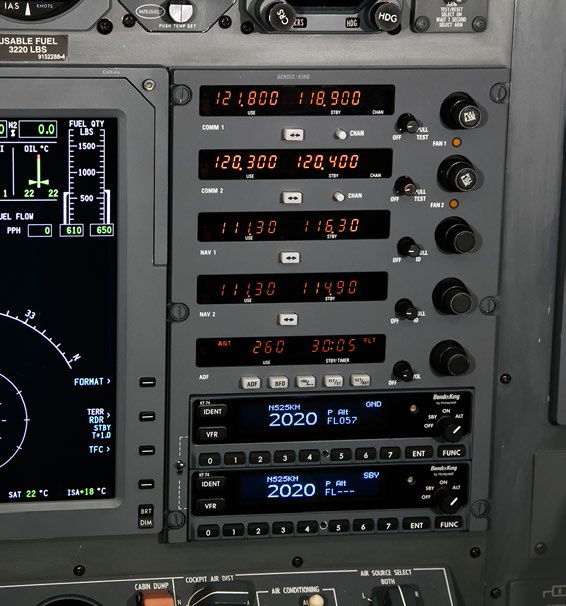
Can we supply ADS-B "IN" data to our Honeywell MFRD?
There is no ADS-B In display option for a Honeywell MFRD. An iPad or other Flight Bag is the only option.
 Haz tu pregunta
Haz tu pregunta Faça sua pergunta
Faça sua pergunta Download Ref
Download Ref